Common Pest Birds You May Encounter in Arizona
When is a bird considered to be a Pest Bird
Native Arizona birds like cactus wrens, finches or cardinals are beautiful and amazing creatures that we should all enjoy seeing when we are out at a park or watching from our window.
Non-native birds on the other hand like pigeons, sparrows or starlings were introduced into the United States a long time ago and since that time have become a real problem in Arizona especially as you may now be learning if they are nesting or roosting on your home or business in large or even small groups - Not So Cute Now Are They?
The Problem with Pest Birds
Did you know that pest birds clog roof drains with their feces and nests, pigeons poop 47 - 51 times a day, the bird droppings will eat at the finish of your car, it will reduce the life of your roof by 20% or more, bird feces has even been found to contain over 60 different diseases and 40 different parasites that could harm or be passed to you, your loved ones, pets, clients or employees.
Pigeons - The # 1 Urban Pest Bird
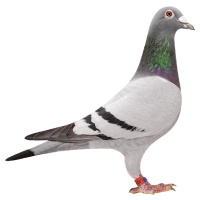
Feral pigeons (Columbia livia) are the number one urban pest bird, causing damage where ever they nest or roost. Pigeons are descendants of domesticated European homing pigeons or Rock Doves, so they have a varied diet and feel at ease making their homes in man-made structures.
Generally blue-grey in color, with iridescent feathers on the head and neck, pigeons often have markings in black, white or brown on the wings and neck.
A short neck and small head characterize the standard pigeon; their short legs, hind toes and level front allow for both easy perching on pipes and ledges or walking on flat surfaces.Best Replica Watches Pigeons generally nest in small, flat areas away from the ground such as building ledges, air conditioning units or window sills.
Pigeon control methods
The best solution for pigeon problems, is complete exclusion with a 2" mesh net. Many ledge problems can be solved by using products such as Bird Coil, Bird wire, Bird Spikes, as well as Bird-Shock Electrical track. When bird pressure is heavy in an area, exclusion work must be accompanied by flock dispersal methods like trapping . Flock dispersal alone is not a long term solution especially in medium-heavy pressure situations like when there are food/water/shelter sources at the site.
Sparrows - Danger to Native Song Bird Population
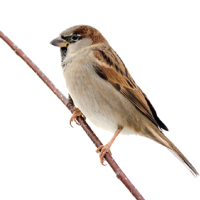
The House Sparrow is the number two urban pest bird. Introduced as a species to North America, the house sparrow quickly spread across the country due to its lack of natural enemies and its adaptive traits. Its ability to nest in urban structures, eat urban scraps and a large breeding capacity are some of these adaptive traits. Omega Replica Watches
The House Sparrow is actually a member of the weaverbird family and not a true Sparrow. Weaverbirds create intricate nests and relative to their size, the largest nests in the bird world. Their legs and toes are favored for branch perching and their short conical bills are ideal for seed cracking.
Their diet consists of seeds and grain, as well as fruits, vegetables, human table scraps and insects. They are boisterous, intelligent birds who roost in noisy flocks on branches of city trees, ivy covered walls and under eaves of houses.
Sparrow control methods
 The most effective method of control is to exclude sparrows from the area with 3/4" Net, making sure there are no gaps or crevices for the birds to pass through. The only ledge deterrent systems that are truly effective against sparrows are electrified ledge systems that use an intermittent pulse like Bird-Shock. New 2-chambered Sparrow Traps are quite effective at trapping small quantities of sparrows. The best trap has an elevated second chamber that keeps the birds happy and so content that they actually sing, attracting others to the trap. When practical, the trapping program should be combined with a nest removal program that will greatly reduce the population over time. Along with trapping, mist nets can be installed in the flight paths by certified personnel to capture these birds in enclosed areas. A new technique that has found some success for moving populations is to fog problem areas with ReJeX-iT. This method is most commonly applied when sparrows gather in flocks. Sparrows generally do not react to audio and visual products except occasionally in areas to which they are not very committed (new to area).
The most effective method of control is to exclude sparrows from the area with 3/4" Net, making sure there are no gaps or crevices for the birds to pass through. The only ledge deterrent systems that are truly effective against sparrows are electrified ledge systems that use an intermittent pulse like Bird-Shock. New 2-chambered Sparrow Traps are quite effective at trapping small quantities of sparrows. The best trap has an elevated second chamber that keeps the birds happy and so content that they actually sing, attracting others to the trap. When practical, the trapping program should be combined with a nest removal program that will greatly reduce the population over time. Along with trapping, mist nets can be installed in the flight paths by certified personnel to capture these birds in enclosed areas. A new technique that has found some success for moving populations is to fog problem areas with ReJeX-iT. This method is most commonly applied when sparrows gather in flocks. Sparrows generally do not react to audio and visual products except occasionally in areas to which they are not very committed (new to area).
Gila Woodpeckers - Smart Little Bird, That is Hard to Get Rid Of
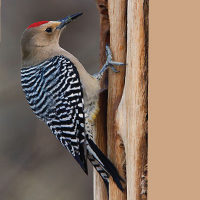
Woodpeckers primarily feed on tree or wood-boring insects using their strong beak and long tongue to dislodge food. Some members of the Woodpecker family (Flickers) feed on insects of the ground, while others prefer native berries, fruit and nuts.
Arizona has what is called a "Gila Woodpeckers" and they are protected by law from shooting or trapping without a special permit from the Fish & Game Department. It is commonly known that woodpeckers peck into wood. They do this for a several reasons; (1) search of food; (2) mating call; (3) nest building; (4) food storage. A common misconception is that woodpeckers only peck for food. "Woodpeckers have characteristic calls, but they also use a rhythmic pecking sequence to make their presence known. This is known as "drumming" which establishes their territories and attracts mates.
Gila Woodpecker control methods
The most effective control method is 3/4" Net that can be installed in a semi-permanent configuration until nesting behavior has been permanently modified. Alternatively the combination of scare devices like the noise activated scare spider and reflective streamers used together work often enough to warrant trying to start with before getting to crazy. Taste deterrents like the Protective Coating Spray, Hole Filler or Paint Additive combination don't seem to work for the Gila Woodpecker.
Starlings - Large Flocks make a Big Mess
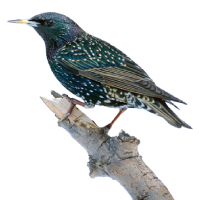
Like the house sparrow, the starling was introduced from Europe in the 19th century. It did not spread as fast and only reached the western coast within the last few decades.
Starlings are well adapted to urban life which offer it an abundance of food and nesting sites. It is a muscular bird about eight inches long with long wings and a short squared tail. Starlings are very aggressive and will drive native birds out of their territory, much to the dismay of local bird watchers. Starlings are well noted for their flocking habits. They often gather in the tens of thousands, creating a nuisance when roosting in populated areas.
Starling control methods
Starlings roosting habits can be modified permanently using Galvanized Hardware Screening, 1-1/8" mesh net and/ or electrical systems like a Bird Shock Track. For large flocks or agricultural applications, these birds can sometimes be moved with a well-timed, organized scare campaign using strategically placed sophisticated audio systems like the Bird Wailer or Squawker units depending on the size of the area. These products combine natural and electronic sounds like species specific distress calls, predator hunting/attack sequences and canon or shotgun sounds.
Grackles - Aggressive, Takes Food Right Off Your Plate
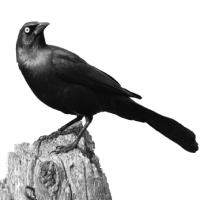
Grackles are boisterous, abundant members of the Troupial Family. ?The common grackle has a green/blue or purple iridescent tinted black plumage with a glossy purplish head, neck and breast with the female of the species, slightly smaller and duller colored.
Grackles can cause several types of damage. As they are scavenging birds, large numbers can be found at dumpsters, food courts and other human areas where food is present. The resulting amount of fecal matter creates unsanitary conditions and can result in physical damage from the uric acid. They are also an agricultural pest bird because they will eat small seedlings and damage crops.
Grackle control methods
There are numerous products and techniques available to combat nuisance Grackles. Like other members of the blackbird family, using noisemaker units like Bird-Gard, Bird Squawker and Bird Wailer units projecting natural distress calls and frightening sounds (selection of units depends on size of area to deter birds as well as severity of problem) can be used to sometimes move them from a site. If they are too entrenched to be scared away, exclusion using 1-1/8" Net or Bird Shock track on ledges will be necessary. Grackles are too nimble for traditional mechanical ledge products. Fogging a roosting winter flock with ReJeX-iT irritant has also shown some success.
Barn or Cliff Swallows - Big Mess Around Nesting Sites
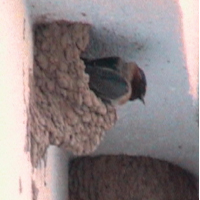
These sleek little birds are well known for their long migration and nesting habits. Cliff and barn swallows spend their winters in South America and summers in North America. They arrive around March in the southern part of the country, reaching the northern states in April. Swallows are very territorial and will always come back to the same nesting site. Swallows have made a very successful switch from cliffs and caves to man made structures for placement of their mud pellet nests.
Swallows can be a nuisance in suburban areas due to their nesting habits. The mud nests damage and deface the outer walls and eaves of residences and office buildings. Building sides often end up smeared with feces from the bird colony along with collecting on the ground. Homeowners have also reported problems with parasites entering the house through building cracks next to the nests which poses a potential health risk to humans and animals.
Cliff Swallow control methods
All Swallows enjoy special protection under the law. You cannot disturb them once they lay their egg in the nest. The only way to eliminate cliff and barn Swallow problems is to take down the nests in the winter after they are gone and exclude them from returning by using 3/4" Net. The netting needs to be angled across the eaves to prevent access to any sharp building angles. Bird Slide or Slope installed upside down has also shown good results.
Goose - Can be Aggressive when Protecting Nesting Site
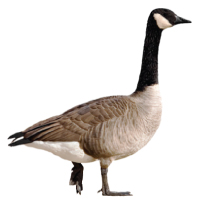
By definition, Canada Geese are not classified as pest birds and are afforded protection by Federal & State agencies. Nonetheless, Canada Geese are increasingly becoming the scourge of suburbia as their numbers have grown in the past decade from only a few thousand to hundreds of thousands of these birds.
In fact, the familiar V shaped squadron of honking geese heading south is becoming a rare sight. Country Clubs and business parks offer tasty manicured lawns and ponds providing an ideal habitat and effectively modifying their migration cycle. Geese are very opportunistic and easily exploit the new 'easy living' conditions found in an urban environment.
Gees control methods
Non-migratory Canada Geese are difficult to remove. Once established, immediate corrective landscaping and behavioral modification is imperative: Remove cover shrubbery; use herbicides to eliminate aquatic vegetation; and reduce fertilizer, especially around pond area, to make grass less nutritionally attractive. Several visual scare products like the Goose Guard and Flash Tape combined with a taste deterrent should be employed as soon as the birds enter the area, varying in location and type. For more established flocks audio scare devices that project a variety of sounds through several speaker locations in a random pattern should be set up at strategically placed intervals. All systems require constant re-enforcement and should be relocated frequently, to remain a convincing threat to the birds. Physical barriers such as overhead Grid wire and 4" mesh Net can be extremely effective barriers but are site specific. These grids can be installed above water surface to prevent landing. Fencing made of Grid wire (.96mm) provides a discrete barrier to dissuade geese from entering property (especially from water areas) and can be electrified for increased effectiveness.
Crows - A Big Smart Bird
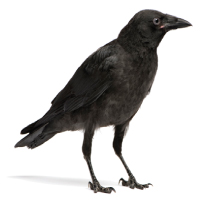
There are two main species of Crows, the large common crow found across the country and the smaller fish crow found in the Southeast. The Common Crow is a big black colored bird approximately 17 to 20 inches long with a strong stout build and a compressed bill. They have a scavenger's diet and will eat a wide variety of things. Such food items include insects, frogs, small snakes, eggs, mice and dead animal carcasses.
Crows will also eat newly planted crops such as corn. Crows are well known for their intelligence. They are social birds and the flock is in constant communication making hunting or capture of the bird very difficult. The Crow's native history along with its helpful bug eating habits have insured its Federally protected status.
Crow control methods
It is possible to drive away large flocks of Crows and other blackbirds with audio/visual scare devices such as the Bird-Gard unit combined with visual scare devices like Scare Eye Balloons, Octopus and Flash Tape. To maximize effectiveness, hang visual products in trees before commencing noise campaign. They can be kept off ledges using 5" Bird Coil, Bird wire, Bird spikes or Bird-Shock electrical track. Two inch mesh Net will exclude Crows completely from most areas.
Turkey Vultures - More of a Problem on High Rise Buildings
The Turkey Vulture do not win any beauty contests. The birds' shape and head look similar to a Turkey, with a red head and dark body feathers.
This large bird lives all across the U.S. The small featherless head is ideal for foraging inside of dead animals, like deer, raccoons, and cattle. They generally hunt their prey by hovering about 200 feet above the ground.
Although the Turkey Vulture generally migrates, it may stay put during our mild winters. They generally live over open plains, desert or forest. Groups of 20 or more may roost in trees and towers, and leave when the warm, rising air makes it easier to fly.
Turkey Vulture control methods
All members of the vulture family are protected under the Migratory Bird Treaty. This is a heavy, aggressive bird that can literally destroy many standard control products. The most effective methods of control are electrified heavy duty wire systems like Bird Fence (call our offices for more details on this product) or Bird-Shock electrical track products. In some
Call Us Now, Put an End to your Pest Bird Problems
We can usually Meet or Beat most any other written estimate from other licensed competitors in Arizona
Due to our many years of experience Southwest Avian Solutions can offer very competitive prices for your home, office or structure bird control problems without compromising integrity and / or quality, backed with our 5 year or 3 year Bird-Free Guarantee.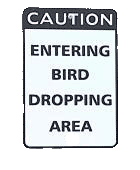
Don't wait any longer, call Southwest Avian Solutions,LLC. Monday thru Saturday from 8:30 AM - 4:45 PM at 602-942-6550 or 480-969-2337 to schedule your "NO OBLIGATION SITE SURVEY", see how we can help solve your pigeon or pest bird problems with our many different discrete bird deterrents to bird proof your residential or commercial property and help you finally put an end to all the hassle, mess and health issues caused by your pest birds or pigeon control problems on your home or business.
Our Service Areas
All of our Bird Control Services are offered in:
Ahwatukee Az, Anthem Az, Apache Junction Az, Avondale Az, Buckeye Az, Carefree Az, Casa Grande Az, Cave Creek Az, Chandler Az,
El Mirage Az, Eloy Az, Fountain Hills Az, Gilbert Az, Glendale Az, Gold Canyon Az, Goodyear Az, Higley Az, Litchfield Park Az,
Maricopa Az, Mesa Az, Paradise Valley Az, Peoria Az, Phoenix Az, Queen Creek Az, San Tan Valley Az, Sun City Az, Sun City West Az,
Sun Lakes Az, Surprise Az, Tempe Az, Tolleson Az, Waddell Az, Youngtown Az, Arizona Az.
Outside Maricopa County - No Residential Services - Only Commercial Bird Control Projects are offered In:
Bullhead City Az, Flagstaff Az, Florence Az, Globe Az, Kingman Az, Lake Havasu City Az, Las Vegas Nv, Laughlin Nv, Nogales Az, Payson Az, Prescott Az, Quartzsite Az, Yuma Az, Sedona Az, Tucson Az, Wickenburg Az, Utah, Nevada, New Mexico, Colorado



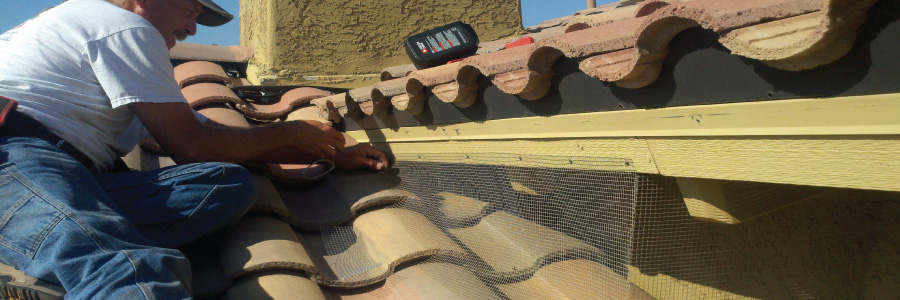


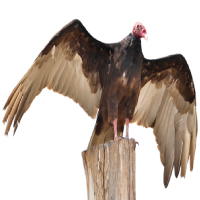
Scheduling Information
Please Call - 602.942.6550